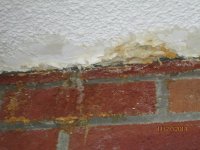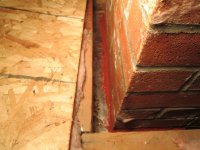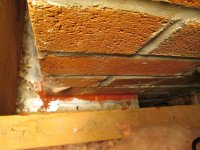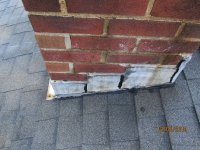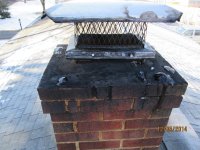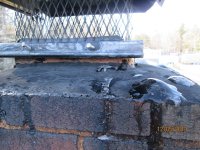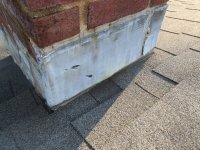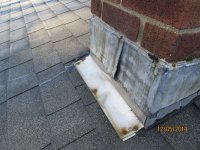In the attic, you see the top of the rafters that box out the chinmey in the pictures? Should I put metal flashing around that, connect it to the chinmey and re-seal it with chaulking?. That way it will be sealed all the way around the chimney??
Thanks
Barry
Yes, use metal flashing sealed to both the masonry AND the framing to make a reliable and fire-proof (= code-legal) air barrier. Seams in the metal flashing can be sealed with a fire-rated fiber reinforced duct-mastic, which can also work for sealing it to the masonry (though it's easier to use a fire-rated caulk or foam to seal it to the masonry.)
Conditioned space air leaking through the gap in the chimney chase brings massive amounts of moisture into the attic. It's important to seal any other penetrations between the conditioned space and attic too, but that looks like a fairly big one. Other big ones tend to be around plumbing-stack chases and electrical penetrations.
Recessed lighting fixtures can also add up to a substantial air leak too. Fixing those can be done with a cardboard box over the top of it with the box seams sealed with housewrap tape, foam-sealing it to the ceiling gypsum (and where the wiring passes). To meet code the box has to have 3" clearance between the box & fixture, but you can then insulate over the box with the same thickness as the rest of the attic insulation. This is often easier to do well with blowing wools or cellulose than with batts, since it's nearly impossible to eliminate gaps & compressions insulating around a box with batts. With squared-off boxes as the cover it's sometimes possible to do OK with high-density fiberglass or rock wool batts trimmed carefully to fit with a bread knife (or purpose-made insulation knife, if you have one.) But fluffing up cellulose with your fingers and heaping it on works just fine too. In MA to meet currrent code-min(R49) you're looking at ~14-15" of insulation over everything, but most homes built before 2010 will have less than that.
It may be worth getting a
MassSave audit and hiring an insulation contractor to both air seal & insulate the attic, (which is subsidized to the tune of 75%, up to a max benefit of $2000 per project.)
An oil-fired furnace or boiler (which is it?) really needs a stainless steel flue liner to protect the masonry from deterioration from exhaust condensation. If your oil-burner is vented into a terra-cotta lined chimney it can still be OK as long as the liner isn't oversized for the BTU rating of the burner, which keeps the exhaust velocity up and the surface temp of the terra cotta high enough to avoid condensation. The condensate of oil exhaust is quite acidic, and will attack the mortar joints of the brick first. The mortar in the pictures all looks just fine, it looks like something dripped down it from above, either water condensation or roof leak. It doesn't have the typical appearance of a chimney that has rotted from within by oil exhaust condensate, but it might be just the beginnings of such. If you have flue condensation going on you'll usually see it seeping out of the joints where the vent stack enters the chimney, a brown or black liquid that rusts out the sheet metal fairly quickly, usually long before it's evident in the masonry.
If the boiler/furnace has been swapped out or the burner re-jetted for a lower firing rate it would make exhaust condensation more likely. If it's a hydronic (pumped hot water) boiler set at too low a temperature (the low-limit temp should be 140For higher) or only firing very intermittently, that could result in flue condensation as well. A stainless flue liner is expensive, but would eliminate further structural damage. It's worth inspecting to verify whether it has a stainless liner or not.
It's also possible that you have very porous brick that is soaking up enough rain that it dribbled down inside the chimney and seeping out through other seams, or a cracked/unsealed chimney crown letting bulk water in. If the mortar crown on the chimney is cracked it should be repaired, but if it's all otherwise intact, a silane/silex type masonry sealer application over both the crown & brick facing on the interior could cut the seepage issue down an order of magnitude or two. In snowy MA a stainless steel chimney cap wide & long enough to serve as a rain/snow shed over the entire chimney top is also worth considering, if you don't already have one.
Run through
this checklist, which probably covers 90% of all chimney related rain-leakages issues.

